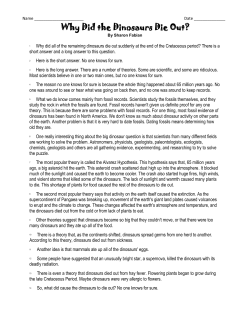
The Scoop On Dino Poop
What’s as big as a loaf of bread, weighs as much as a frozen turkey, and tells us what dinosaurs ate? as a coprolite. The scoop on dino poop is finally flushed out! Coprolites don’t smell like poop after millions of years, because they’ve turned to stone. Their shape varies from small pellets to long logs, from curly spirals to flat pancakes. They also vary in color. By studying coprolites, scientists have discovered what dinosaurs ate. Carnivorous (meat-eating) dinosaurs’ coprolites yech! contain bone fragments, teeth, fish scales, The Scoop on or snail shells. And herbivorous (plant-eating) dinosaurs’ coprolites contain shredded wood, stems, leaves, flowers, or seeds. Dino Poop ! w ee 4 ©2007 by Heinemann and Carus Publishing from Toolkit Texts by Stephanie Harvey and Anne Goudvis (Portsmouth, NH: Heinemann). This page may be reproduced for classroom use only. u ! k c Give up? It’s petrified dinosaur poop, also known ©2007 by Heinemann and Carus Publishing from Toolkit Texts by Stephanie Harvey and Anne Goudvis (Portsmouth, NH: Heinemann). This page may be reproduced for classroom use only. ! s s o gr A world-record coprolite was recently found in Saskatchewan, Canada. It’s 17 inches long and 6 inches around. The coprolite contained the crushed bones of an unfortunate herbivore. The poop came from the largest carnivore in the area, a Tyrannosaurus rex. This coprolite tells us not only what T. rex ate but how it ate. Previously, scientists believed that T. rex swallowed large chunks of meat and bones without chewing. But after examining the coprolite, they now realize that T. rex crushed mouthfuls of bones as it chewed. Bone fragments passed through the dinosaur’s intestines in its poop. Dr. Karen Chin is one of the scientists studying this giant T. rex coprolite. In fact, Dr. Chin is the world’s leading paleoscatologist—a scientist who studies fossilized poop. To find out what’s inside a coprolite, it is cut open, x-rayed, smashed, or sliced into superthin slices. The slices are studied under a powerful microscope. Dr. Chin is never sure what “jewel” she might find inside each coprolite. Who would have guessed that lumpy rocks could reveal such important information? ly l a e r r e a ll y ss ! gro Another “sick” discovery was recently made— fossilized vomit. Paleontologists Peter Doyle and Jason Wood uncovered the world’s oldest vomit in Peterborough, England. The 160-million-year-old vomit contained dozens of belemnites, a squidlike animal. The vomit came from an ancient sea creature called ichthyosaur. Ichthyosaur, who lived at the time of dinosaurs, probably threw up to prevent a stomachache. Amazing! Creatures have had stomachaches for a long time! Paleoscatologists, that’s who. Adapted from an article by Mary Meinking 5
© Copyright 2025













